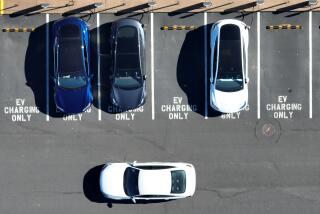Sun-Run Cars : Engineers are already working to build a network of ‘filling stations’ for solar-powered electric autos and trucks.
“Fill ‘er up, Mr. Sun” might well be what you’ll be saying when you drive up to the pumps at the service station of the future. That’s because a Camarillo manufacturer, Siemens Solar Industries, has recently begun installing photovoltaic (solar power), electric-generating panels on “filling stations” for electric cars and trucks.
Anti-smog laws and the fear of foreign oil dependence have prompted state governments from here to New York and Florida to mandate increased use of battery-powered electric motors for cars and trucks. Last week, Calstart, a Southern California business consortium, unveiled a locally made electric car at a converted Lockheed plant in Burbank. According to the California Air Resources Board, by 1998, we can expect 40,000 similar vehicles to be on California roads.
The question many wary commuters may ask, however, is: Aside from charging those engine-driving batteries at home at night, where can we expect to juice up when we’re on a long commute or trip?
Mark Stimson, Siemens’ communications manager, provided an answer by way of describing a facility in Tampa, Fla. By coincidence, that’s where I’m headed this weekend. Tampa is where Siemens’ Ventura County-made solar cells are powering America’s very first zero-pollution filling station.
I do mean zero. No leaky underground fuel tanks. No vapors when you pump. No gasoline tanker trucks careening around the neighborhood. And because the electricity involved doesn’t come from a smokestack-equipped electric power plant, no air pollution anywhere.
I don’t have an electric car yet, but I’m going to visit the filling station anyway out of curiosity. OK, that’s Florida. What about Southern California?
Well, Edison, our local utility, just broke ground to construct a sun-powered service station last week over in Diamond Bar, at the headquarters of the South Coast Air Quality Management District.
Stimson pointed out that there’s lively competition going on in this particular environmental arena.
Siemens’ installation, put up in July, was the first in the nation. The second was at the headquarters of the Sacramento Municipal Utility District, put up in August. SMUD, as it’s affectionately and officially called, moved in some photovoltaic panels from its decommissioned Arroyo Seco generator, so Siemens wasn’t involved.
Edison’s “charging station” in Diamond Bar, east of Los Angeles, which will be operational in the spring, is using solar cells made in Maryland by Solarex, a subsidiary of Amoco.
Siemens isn’t suffering for business, however. According to Stimson, shipments of its product--which looks like a black glass domino--are increasing 20% a year. There are about 14,000 of them arrayed like mini-roof tiles at the site in Tampa. This cost the station’s operator, the University of South Florida, a one-time $30,000, according to Tom Smith, the engineer in charge of the project.
“They (the cells) are working very well--a very good product,” Smith said. “We expect they’ll last 20 years.”
Smith is working on ways to cut down the time that is necessary to leave your car or van plugged in to his 12 “pumps”--which actually are the poles holding up the station’s “roof” of solar cells. Right now, it takes all day to charge the batteries, accomplished while the university’s employees with electric vehicles are at work.
Smith hopes to cut this to five minutes. According to experts, a 15-minute charge already is within reach. That’s what engineers are for, I guess.
Back here in California, researchers at Hughes Power Control Systems in Torrance are also working on a fast-fill method for an electric service station. Their futuristic “public charge” station depends on the success of research such as Smith’s.
Hughes is pushing hard on decreasing the charge time because it’s connected with the General Motors “Impact” project--expected to be the first mass-produced electric car. Unless something like the proposed Hughes stations are up and running throughout California by the late 1990s, GM won’t be able to sell any Impacts.
Independently, the Los Angeles Department of Water and Power opened four electric vehicle-charging stations in September, the first of 60 planned for Southern California. The Hughes and DWP sites will get their juice from existing power lines--not from the sun.
“But we do have plans in ‘93,” according to a DWP spokesman.
While the engineers sweat out the best way to quick-charge an electric car, Siemens is also working on lowering the cost of photovoltaic solar electricity. In 20 years, due to new manufacturing methods, the photovoltaic industry has reduced costs from the equivalent of $30 per kilowatt hour to just 30 cents.
But that’s still three times what conventional non-sun-powered generating plants--the ones with the smoke stacks--charge.
But gee whiz, if the folks at factories like Siemens’ Camarillo facility can reduce the cost of making electricity from the sun 1000% in two decades, they should be able to get it down by a mere 50% in the next few years.
I’m excited by the prospect of filling up my car at competitive prices on renewable non-polluting solar energy. Aren’t you?






